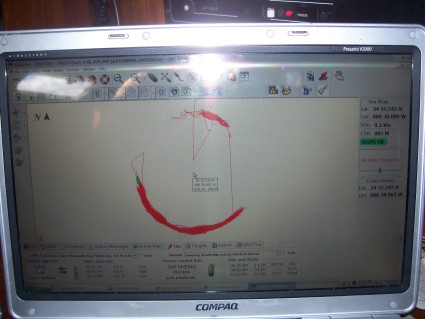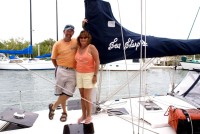Retirement to Bahamas
Mike and Judy have been sailing for some 25 years. We have dreamed for years about retiring and sailing to the Bahamas and Caribbean. We are living our dream!
05 February 2013 | Riverside Marina
26 March 2012
17 March 2012
16 March 2012
15 March 2012
15 March 2012
06 March 2012
06 March 2012
04 March 2012
28 February 2012
26 February 2012
26 February 2012
26 February 2012
26 February 2012
25 February 2012
25 February 2012
25 February 2012
21 February 2012
21 February 2012
12 February 2012
Anchoring 101 (Part 1)
04 February 2010

Yeah, I know, the sailors among the blog readership will be thinking, "what makes him an expert on anchoring?". Non-sailors reading this post may think, "what's the big deal on anchoring? You just throw out a heavy weight attached to a rope and it'll stop the boat."
While to the former readers, I don't profess to be an expert by any means, to the latter, there's a lot more about anchoring than tossing out a heavy weight. In fact, secure anchoring is perhaps one of the most critical aspects of a cruiser's activities. And, it's a very complex and variable process.
Now you may think of the standard anchor as that traditional fisherman's anchor as depicted on Popeye's and my tattoos (our physical similarities stop there). Well this could not be farther from the truth. No one uses that old-fashioned anchor anymore. In fact, the design of anchors is now a very sophisticated process; designers using computer models and CAD/CAM to perfect the perfect anchor. There are CQR's, Danforths, Bruces, Deltas, and any other assortment of makes and models. And each new entry purports to be the cat's meow (apologies to Chopin) in holding your boat safely.
Just go to a boat show and take in the succession of booths purveying their newest brand of anchor, with their little box of sand or gravel and scale models of their new anchor compared to the competition. The customer is entreated to drag each mini anchor through a miniature bed of sand or gravel along with the competition and, of course, all fail except the exhibitor's. Go to the next booth with another array and, of course, the aforementioned fails and the new one miraculously holds much better. It ain't a simple thing.
So in addition to choosing the right anchor(s) there are many other factors. How much chain? How much rode (rope)? Do you set two anchors in a Bahamian moor? Do you add a kellet to the line?
Like the non-sailors whom I referenced at the outset, I started my sailing career thinking that the anchor was basically a weight which held the boat in place. In fact, I recall well Judy and my first charter in the British Virgin Islands with our sailing buddies Mike and Debbie. Our experience to this point was a summer on our Thunderbird on Grand Lake where indeed you could throw out a weight and it would hold you in place. Well, we chartered a tired but capable CSY 37 for a week with no clue. Us intrepid sailors let Road Town, Tortola and headed across the Sir Francis Drake Channel to Norman Island (a remarkable four mile passage) and pulled into this crowded but picture perfect anchorage. With me at the helm, Mike tosses out the anchor (the windlass, like many other things on this boat did not work) and lets out enough chain for the anchor to hit the bottom. We break out the libations and celebrate our bravery and skills but shortly are dragging down onto our neighbour's boat. He yells out to us to let out more scope. Huh? What's scope?
Well, to get back to the lesson, anchoring a modern boat is not simply about the weight of the device attached to the line but is all about a fancy word called "catenary". It's essentially the curve of the line holding the boat to the device which allows the anchor to be pulled along and ultimately into the sea bed thereby hooking the boat to the bottom. Our mistake of dropping just enough line for the anchor to reach the bottom was a juvenile but understandable one. Rather you have to let out sufficient chain/rope to allow for a sweeping angle of attach so that when the boat strains against the anchor it pulls it along the surface and eventually burying into the bottom. The more the push of the boat the more the anchor should bury itself and provide holding power.
There are various rules of thumb as to how much "scope" you should use. Scope is a fancy term for the ratio of length of line to depth of water. And, to make it more complicated the recommended scope varies depending on whether you are using rope or chain rode, the type of sea bed, the wind strength, the proximity of neighbouring boats, etc. An average might be 5 to 1. In other words you let out five times the length of chain/rope to the depth of the water under the boat (actually it's the water depth plus the height of the bow out of the water). So, for example, here in Islamorada where we are currently anchored, we are in 8 feet of water and the bow of the boat is about five feet high for a total of 13 feet. Based on the five to one we should let out 65 feet of chain (in fact we have more like 80).
I leave on my navigation system so it tracks the movement of the boat at anchor as it moves back and forth, pivoting on the anchor. The pic shows the screen with the movement of the boat around this axis over the several days we spent here. If we were to have remained and given the cyclical nature of the winds, it would eventually have completed this etch a sketch like circle. (note that there is a gap on the right hand side in the circle; I turned off the system to save power that day that it was very calm.
To be continued.....
Comments
| Vessel Name: | Sea Sharp |
| Vessel Make/Model: | Hunter Legend 37.5 |
| Hailing Port: | Douglas Harbour, NB, Canada |
| Crew: | Mike, Judy and Chopin (the boat cat) |
| About: |
Gallery not available
Preparing for Retirement Trip

Who: Mike, Judy and Chopin (the boat cat)
Port: Douglas Harbour, NB, Canada